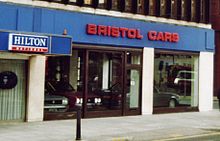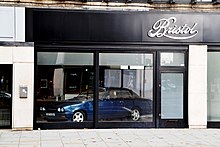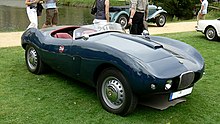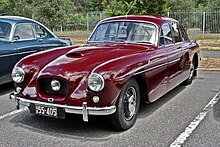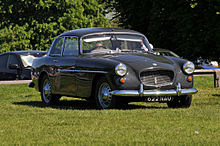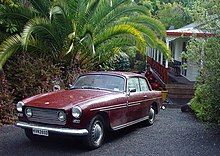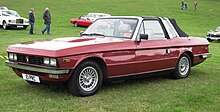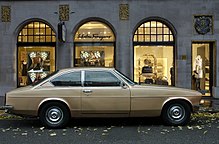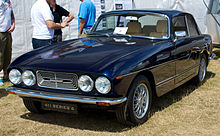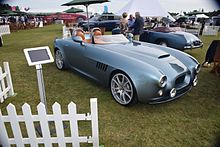Bristol Cars
| Bristol Cars Ltd.
|
|
|---|---|
| legal form | Limited |
| founding | 1946 |
| resolution | 2020 |
| Seat |
Filton , United Kingdom Windlesham , United Kingdom |
| Branch | Automotive industry |
Bristol Cars Ltd. was a British automobile manufacturer that was heavily involved in racing in the 1950s and produced exclusive luxury vehicles by hand from 1946. Production was based in Filton near Bristol . In the first few years there was a close relationship with BMW , whose pre-war models were the technical basis for Bristol's designs. Since the 1960s, Bristol has been building very low numbers of high-priced coupés and convertibles with American drive technology from Chrysler and idiosyncratic, sometimes bizarre bodies. Originally a subsidiary of the aircraft manufacturer Bristol Aircraft Company , Bristol Cars had been a privately held company since 1960, owned by former racing driver Tony Crook . At the beginning of the 21st century, Bristol touted to be the last fully British-owned automobile manufacturer. With the outdated Blenheim and the very expensive Fighter high-performance sports car , the company, which was largely limited to the British market, was ultimately no longer successful. The last new vehicles were manufactured in spring 2009. After that, the company only dealt with the restoration of older models of its own brand. In March 2011 Bristol Cars went bankrupt, after which the Swiss company Kamkorp Autokraft took over the automaker. After five years of development, Bristol presented a completely new model, the Bullet, in 2016 , which was intended to revive the connection to BMW. However, series production did not materialize. At the end of 2019, Bristol was again insolvent. The company has been liquidated since 2020.
Company history
The Bristol Aircraft Company was one of the best-known British aircraft manufacturers and engine builders between the World Wars . It produced the light to medium bomber models Bristol Blenheim and Bristol Beaufighter for the Royal Air Force . After the end of the Second World War , all armaments companies had to look for new fields of activity because of the drastically worsened order situation. Bristol decided - similar to Saab - to turn to the automotive industry. During the Second World War, Bristol had already developed two very different vehicles with their own drive technology, of which several prototypes were produced by 1946. In the spring of 1946, however, the company decided against building these vehicles and instead adopted a German design that ultimately became the Bristol 400.
Relations with BMW
The external reason for this decision was the takeover of the British automobile manufacturer Frazer-Nash by Bristol in June 1945. HJ Aldington, one of the owners of Frazer-Nash, had visited the BMW director Franz-Joseph Popp in Munich in 1934 and had the rights to build and Distribution of some drafts of BMW models in Great Britain, which were sold there as "Frazer-Nash BMW". In July 1945 Colonel Aldington bought one of the Mille Miglia - BMW 328s .
Aldington took over a large number of construction drawings for the BMW models BMW 326 , 327 and 328 in the first few weeks after the end of World War II ; he was also able to win over BMW engineer Fritz Fiedler for a collaboration with Frazer Nash. Given the new relationship with Frazer-Nash, Bristol stopped developing its own car in early 1946 and focused on adopting and adapting BMW's designs. This decision made it possible to set up its own automotive division quickly and inexpensively, but it also meant that Bristol would use a pre-war design instead of a new development. Production of a 400 saloon prototype began as early as September 1946 and was presented for the first time at the Geneva Motor Show. The car was initially advertised as Frazer-Nash-Bristol ; a little later, however, the name was reduced to Bristol. In April 1947, Bristol and Frazer Nash separated. Bristol continued building the 400 under its own management; Frazer-Nash then built sports cars, mostly using Bristol engines.
The question of the extent to which German designs were used with the approval of BMW has not yet been clarified. Individual sources assume that Aldington and Bristol originally received the documents as part of war reparations; others suspect crimes in a de facto lawless area due to the war. Still other sources assume that the BMW headquarters in Munich preferred to see the documents in the hands of the western allies than in those of the Soviet Union , which already had the BMW automobile plant in Eisenach as a consequence of the war . Going further is the thesis that due to the long-standing contacts with Frazer Nash and Aldington from the 1930s, BMW consciously cooperated and received consideration or commitments in order to be able to resume automobile production in post-war Germany itself. In this context, the fact that BMW - unlike the East German EMW - did not prohibit Bristol from using the brand-typical "kidney", so that this design element was used until the Bristol 403 was discontinued in 1955, is significant . The nomenclature of both brands suggests a tacit agreement: BMW had produced vehicles of the 300 series until the Second World War. Bristol picked up on this from 1946 when a new series was launched with the 400. BMW, on the other hand, never produced vehicles of the 400 series, but started production again with the 500 series after the Second World War .
The beginning: in association with Bristol Airplane
By 1959, automobile manufacturing was one of several areas of activity for the Bristol Airplane Company . Initially, Bristol Cars was organizationally a division of Bristol Airplane. In the fall of 1955, auto production was spun off as an independent corporation that was wholly owned by Bristol Airplane.
When Bristol Airplane merged its subsidiary Bristol Aero Engines with Armstrong Siddeley , the engine manufacturer of the Hawker Siddeley Group , to form Bristol Siddeley Engines (BSE) in April 1959 , Bristol Cars was also transferred to the new company. At the end of 1959, the BSE management considered merging Bristol Cars with the automotive division of Armstrong Siddeley into a joint operation. In January 1960, however, it favored the closure of Bristol Cars.
Small Series Manufacturers: George White and Tony Crook
Before BSE could close the automobile division, George White, a leading manager of Bristol Cars, and the London Bristol dealer Anthony "Tony" Crook took over all company shares in Bristol Cars Ltd. in September 1960, which was then separated from Bristol Siddeley Engines and became independent Operation was continued. Tony Crook has been closely associated with Bristol Cars from the start. He had served as a fighter pilot in the Royal Air Force during World War II and had made repeated appearances as a successful racing driver in the post-war period; he had achieved many of his successes in cars fitted with Bristol engines. Shortly after starting car production, Crook began selling Bristol vehicles and by the 1950s had become the brand's most important dealer. On Crook's initiative, some attractive special models went back, namely the sports versions of the types 406 and 407 clad by Zagato.
With the takeover of Bristol by White and Crook, the direction of the company changed: Bristol Cars became a small series manufacturer, which had repeatedly struggled with economic difficulties. Bristol Cars was now largely focused on the British market and also reduced its dealer network here. This development intensified when Tony Crook took over the shares of George White in 1973, who had recently suffered a serious traffic accident. In the Tony Crook era, Bristol was seen as an eccentric brand that catered to wealthy, sporty self-drivers who didn't care about visible status. The long-standing company motto “Nicely understated but never underrated” dates from this time. Accordingly, Crook largely refrained from public appearances since the 1970s; According to Crook, advertising for his cars was limited to “whispering propaganda in English clubs”. The fact that there was no dealer network at all was also unusual: Bristol Cars had been selling the cars directly to its customers since the early 1970s. There was only one - still existing - showroom in the London borough of Kensington .
Since the 1980s at the latest, the economic situation of Bristol Cars was permanently tense. In the 1990s and the first decade of the 21st century, automobile production at Bristol therefore faded more and more into the background. This time was marked by the Blenheim model presented in 1993, which had been on offer for 17 years and was increasingly less attractive given only minor external modifications. According to consistent press reports, hardly more than 20 new vehicles have been produced per year since the mid-1990s. In the end there were only 27 employees working in production. The restoration of classic Bristol models, which was carried out at a high level, was far more profitable.
Takeover by Tavistock
At the end of the decade, Tony Crook saw the need to strengthen the company financially through the involvement of new business partners. According to Tony Crook, several large automobile manufacturers were interested in taking over Bristol in the 1990s; However, Crook ultimately chose a British investor. The choice fell on Toby Silverton, who acted for the Tavistock Group , an investment company of the English billionaire Joe Lewis, who was Silverton's father-in-law at the time. In 1997 the Tavistock Group initially received a minority stake; In 2001 she finally took over the entire company. Silverton then headed the company. Crook initially remained a consultant, but left for good in 2007 at the age of 83 after disagreements between him and Silverton over the further development of the company. Moving away from Crook's policy of discretion, Silverton endeavored at the beginning of the 21st century to increase the external perception of the brand again. In 2009, for the first time in almost two decades, Bristol had a stand at a British motor show. The willingness of the company to manufacture special models and individual items also served this purpose. They included replicas of the Bristol 405 Drophead Coupé or the Blenheim Mk. 4 . On the other hand, Silverton continued to emphasize the individuality of the brand, which now appeared under the motto “Handbuilt cars for individualists”. In 2010, he stated that Bristol had no intention of "slavishly copying every automobile fashion". Bristol deliberately decided not to have a presence in the USA. On the one hand, adapting the current models to the American approval requirements is too costly; on the other hand, Silverton was of the opinion that American buyers generally did not understand the character of a Bristol: Americans were "not interested in cars that cost a lot of money, but you can't tell."
First bankruptcy and takeover by Kamkorp
The takeover by Tavistock initially provided Bristol Cars with liquidity; however, there was no fundamental consolidation. The chairman of the Bristol Owners Club already pointed out the critical situation in 2007 and forecast the company's bankruptcy within the next two years. Bristol's automobile production recently generated losses of £ 300,000 to £ 400,000 annually; These deficits could no longer be compensated for by the other two branches of business - the restoration of old vehicles and the used vehicle trade. The main reason for the financial difficulties in recent years is mostly seen in the high development costs for the super sports car Fighter, which Bristol brought onto the market in 2004 at Silverton's request, but which could not be sold in the required number.
In early March 2011, Bristol Cars entered a state of insolvency. On March 3, 2011, the company was placed under bankruptcy administration. The production area was completely shut down after the bankruptcy petition and the corresponding employees were dismissed, while service and sales were maintained. Bristol's bankruptcy is temporally related to Toby Silverton's divorce from his wife, whose father financed Silverton's Bristol engagement.
Toby Silverton tried in vain to take over parts of the company from bankruptcy. Instead, Bristol Cars was taken over in April 2011 by the Swiss Kamkorp Autokraft, which was part of the Frazer-Nash group . Frazer-Nash develops alternative drive systems for automobiles, including hybrid and electric drives. Under Kamkorp the company headquarters was moved to Windlesham , Surrey . During this time, Bristol did not produce any new vehicles. A Kamkorp spokesman stated in August 2011 that automobile production at Bristol should be resumed with newly designed cars; Several models with electric or hybrid drives and participation in motorsport events such as the Le Mans 24-hour race were promised (“The future for Bristol will be different”). Nothing has come of this so far. In 2016, Bristol only introduced the prototype Bullet. The start of series production announced for 2017, however, could not be realized; the bullet remained a one-off.
Renewed bankruptcy and dissolution
At the end of 2019, Bristol was again insolvent. The insolvency proceedings were opened at the request of a creditor, and the insolvency administrator was appointed in February 2020. Bristol Cars is to be dissolved; the proceeds from the sale of the assets are intended to satisfy the creditors. The Bristol Owners Club will endeavor to take over the material and the archive.
Overview of the Bristol models
In general, Bristol's model policy can be divided into two phases up to the takeover by Kamkorp in 2011: In the first phase, in which Bristol started with its own engines, the company's self-confident appearance could not be overlooked. By far most of Bristol's must have been made during this period. In addition, Bristol engines, which were able to produce up to 140 bhp in the factory version, were sold to Frazer-Nash and AC . Since the 1960s, when Bristol used American eight-cylinders, Bristol preferred a downright restraint and a turn to extreme exclusivity in terms of both external appearance and production numbers, which were only a fraction of the production of the early years.
First prototypes
Between 1940 and 1946, the Bristol Aircraft Company developed two different vehicle concepts that could be considered for entry into automobile production. Both vehicles were largely developed by Sir Roy Fedden, an aircraft engineer who came to Bristol in the late 1930s when the company took over the Bristol-based competitor Cosmos Engineering Company. Ian Duncan, who would later found Duncan Industries , worked with Fedden .
- Feddens first development was a car called Type F . It was a compact car with a three-cylinder radial engine and air cooling. This concept, which went back to an idea initiated at Cosmos, documented Fedden's origins in the aircraft industry. The 1.6 liter engine was installed in the rear. All four wheels were individually suspended and connected with a pneumatic system, which anticipated the concept of the Citroën DS . The body was made of aluminum. The entire car weighed less than a ton. Three prototypes of the Type F were produced in 1945, which differed in numerous details.
- Parallel to the Type F, Fedden developed the Type 2EX , a four-door sedan with more conventional technology. The 2EX had a 2.0 liter, water-cooled four-cylinder in-line engine that was installed behind the front axle and powered the rear wheels. Each cylinder had its own aluminum cylinder head. The body was designed as a four-door hatchback in the pontoon style; there were no separate or protruding fenders. The front of the vehicle sloped forward in a clear arc. The headlights were between the fenders and the grille; they were covered by a movable flap in the style of the Chrysler Newport Phaeton from 1940. Several prototypes of this model were also produced and tested until spring 1946. One of the prototypes was badly damaged in an accident. After that, the development of the 2EX ended abruptly.
Bristol's decision to build and sell a car designed in Germany instead of an in-house design is explained by the collaboration with Frazer-Nash that has existed since June 1945. Roy Fedden later expressed his bitterness over this path in several interviews.
The six-cylinder models
Bristol 400
Bristol's first automobile, the 400 Sports Saloon with rear-hinged doors, went on sale in 1947. Overall, the car was a replica of the BMW 327. The frame, the six-cylinder engine and the body largely corresponded to the German model, even the kidney-shaped radiator grille was adopted. The two-liter six-cylinder developed 85 bhp and accelerated the car to 94 mph. Overall, according to Tony Crook, a little less than 700 copies were built, including several convertibles and at least one station wagon . The first, Bristol 400, built in 1946, was owned by Tony Crook until his death.
Bristol 401, 402 and 403
The obvious resemblance of the Bristol 400 to the German BMW 327 was viewed critically by both company management and the British public. Therefore, Bristol revised the car thoroughly in the following period. In October 1948, the successor model of the Bristol 401 was presented, which did not replace the 400 immediately, but was offered in parallel until 1950. The changes related primarily to the body. The Carrozzeria Touring in Milan had designed a smooth, aerodynamically effective aluminum body, which had no resemblance to its predecessor, with the exception of the grille, but recalled some designs, the Pininfarina at the same time for Alfa Romeo had developed and comparable brands. The known chassis was only modified in individual details; the engine output remained unchanged, but the top speed increased to 98 miles per hour in view of the significantly more aerodynamic body. The price for a 401 was £ 2000 before tax in 1950.
In 1953, Bristol presented a revised version of the coupe called the 403 . This time the body remained unchanged; for this the engine received a thorough overhaul. With a revision of the cylinder head, which got bigger valves, and a few other modifications, Bristol now achieved an output of 100 bhp, allowing the car to reach a top speed of 100 mph. The price rose to £ 2,100 before tax.
A special feature was the temporarily offered Bristol 402 Drophead Coupé, a two-door convertible based on the 401 . Only about 20 copies were built, which gained some notoriety because several Hollywood actors, including Jean Simmons , opted for a Bristol 402 .
Bristol 404
Another special model appeared in autumn 1953: the two-seater sports coupé 404 . It was intended for the wealthy self- driver for whom the five-seater 403 was too cumbersome, maybe too unwieldy. Indeed, the 404 was a significantly sportier vehicle. It rested on a chassis that had been shortened by 45 cm and was 20 percent lighter than the 403 . In addition, there was another revised engine, which now delivered up to 125 bhp with the same displacement. That was enough to give the car a respectable top speed of 120 miles per hour. The hatchback body was independent. It featured a striking radiator opening on the front and subtle fins on the rear. The 404 was the first to show a stylistic peculiarity that was to become a special feature of all later Bristol and is still to be found today in the current models: between the front wheel and the A-pillar, the spare wheel was accessible from the outside via a flap, on the other hand housed the battery. This idea relieved the trunk and also made it possible to place more weight near the center of the vehicle.
The acceptable performance and the serious, but unobtrusive appearance of the 404 soon earned the car the nickname "Gentleman's Express" . The vehicle received unanimous praise from the press; the British journalist John Bolster , for example, described it as a "magic carpet for a quick trip for two" (Auto Sport of October 16, 1953). However, the car did not prove to be a success, and management also admitted that they would have liked to sell more vehicles of this model. A total of 40 to 55 copies of the 404 were made, depending on the source. The low production was mainly due to the fact that the 404 was almost twice as expensive as a Jaguar XK 140 , but not surpassed its performance.
Arnolt-Bristol
A derivative of the model, the Arnolt-Bristol, was more successful than the actual 404 . This is a small coupé or convertible that was built on the chassis of the 404 and was given an attractive body by Bertone in Italy . The initiator of the project was the American businessman Stanley "Wacky" Arnolt from Indiana , who was looking for a powerful and compact sports vehicle with European genes for the American market. Arnolt made the connection between Bristol and Bertone and marketed the vehicles in the USA. When the vehicles were unveiled in 1954, prices ranged from $ 4,000 to $ 6,000 - about half the price the 404 was then. A total of 154 Arnolt-Bristols were sold between 1954 and 1961. Today, the surviving specimens are sought-after rarities that are traded at six-digit dollar or euro prices.
Bristol 405
In 1953 the Bristol 405 was introduced as the first - and so far only - four-door model . He took up some design features of the Bristol 404, including the radiator design reminiscent of an airplane fuselage and the small tail fins on the rear fenders. The 405 was widely praised by the press; However, the entry to the rear seats was uncomfortable given the tightly cut rear doors. On the basis of the 405, the British body shop ED Abbott produced a two-door, Drophead Coupé -called Cabriolet version, which - unlike the sedan - had a notchback line. A total of around 300 copies of the Bristol 405 were made in four years.
Bristol 406
In 1958, Bristol returned to classic two-door coupes. The Bristol 406 used the well-known chassis, but received a 2.2-liter version of the in-house six-cylinder engine, which had an enlarged stroke and delivered 105 hp at 4700 revolutions per minute. A distinctive feature of the car were its four disc brakes, the existence of which Bristol proudly pointed out.
The Bristol 406 was first presented to the public in October 1957. The first exhibition vehicle had an elegant body made by the Swiss body manufacturer Gebr. Beutler from Thun ; however, for series production, Bristol again used its own, self-made body. It was created in the spring of 1958. It was a classic notchback design with pontoon lines. The front section was still similar to the Bristol 404. The C-pillar was moved far back and made it possible to position the rear seat comfortably. This design formed the basis for all later Bristol vehicles up to the Bristol 411 .
The Bristol 406 went on sale in August 1958. The press reports regularly praised the driving behavior and the safety of the new model, but criticized the modest performance, which clearly lagged behind those of the (cheaper) competition from Jaguar or Aston Martin .
The eight-cylinder models
Bristol initially considered producing a more powerful, approximately 3 liter, six-cylinder engine in the late 1950s. Some prototypes are said to have been created and tested by him. Ultimately, however, the production of the engine turned out to be too expensive, so that Bristol refrained from the project. Instead, the plant decided to purchase Chrysler engines from Canadian production, a step that national competitor Jensen also agreed to take around the same time. The connection between this engine and the body of the 406 eventually became the Bristol 407.
Bristol 407 to 411
The Bristol 407 to 411 models form a family. They are based on the chassis and body of the Bristol 406, but have Canadian Chrysler engines. The individual models differ primarily in the design of the front and rear sections as well as the size of the engines used, which began with 5.2 liters in the 407 and ended with 6.6 liters in the Bristol 411. The following models were created:
- Bristol 407 : 1961 to 1963
- Bristol 408 : 1963 to 1965
- Bristol 409 : 1965 to 1967
- Bristol 410 : 1967 to 1969
- Bristol 411 Mk. 1 to Mk. 5: 1969 to 1976.
Bristol succeeded in creating a balanced combination of sportiness and comfort with the models 407 to 411. Mainly due to the restrained exterior design, they were considered conservative and “understated”, as the company motto repeatedly emphasized. They competed on the national market more with the Jensen Interceptor and the Alvis TD to TF than with the coupés from Aston Martin, which were designed for sportiness . International competitors were the Iso Rivolta 300 , the Maserati Mexico or the Monteverdi High Speed 375 .
The Bristol 406 and Bristol 407 models each had exclusive, low-volume, special models with a Zagato body . The successor to the Bristol 411 Mk. 5 was not the Bristol 412 - this model was produced in parallel to the 411 for a while - but the Bristol 603 presented in 1976 .
The eight-cylinder Bristol models were regularly driven by well-known personalities. When Peter Sellers drove a Bristol 407 for a short time and his bride-to-be, Britt Ekland , was photographed with the Bristol, the brand gained additional attention.
The production figures for the 407 to 411 models are unknown. Bristol refuses to provide information on the grounds that precise knowledge of the production figures could have undesirable effects on used car prices. Some sources report that by the time the Bristol Beaufighter was introduced in 1980, a total of around 6,000 vehicles had been handcrafted. However, this number is strongly doubted by not a few brand experts. For example, the chairman of the Bristol Owners Club, which has tried to keep a register of all vehicles produced, is of the opinion that in the 60 years the company has been in existence, no more than 3000 Bristol has been produced. Most of the vehicles are six-cylinder models that were manufactured in the 1950s; since the switch to Chrysler engines, annual emissions have only been in the low double-digit range.
Bristol 412, Beaufighter and Beaufort
Between 1974 and 1993 Bristol produced a safety cabriolet with a Zagato body, which was put to the side of the saloons and was offered in various series. The production figures have been consistently low over the years; British estimates suggest that no more than 150 412 vehicles (in all versions) were produced in 18 years. In terms of price, the 412 was well above the saloons. Several versions were created by 1993: The 412 S1 Convertible Saloon with a 6.6 liter eight-cylinder engine from Chrysler, presented in 1974, was followed in 1977 by the 412 S2 , which, like the closed 603 produced at the same time, was powered by a V8 engine with 5.9 liters . Individual copies of this series were still made in the 1980s; they were optionally equipped with a catalyst. In 1980 the third series of the 412 appeared, which - as a reminder of an aircraft of the same name from the Bristol Airplane Company - was given the designation Beaufighter . The Beaufighter corresponded stylistically largely the previous 412, but had a tuned engine. The well-known eight-cylinder engine from Chrysler was equipped with a Rotomaster turbocharger and achieved a 30 percent higher output than the 412 S2. The Beaufighter was the first British-made car equipped with a turbocharger in series. The Bristol Beaufort presented in 1984 was ultimately a four-seater full convertible without a roll bar. It was equipped with the 5.9 liter eight-cylinder Chrysler engine. This variant remained a one-off.
Bristol 603
On the occasion of the 30th anniversary of the brand, Bristol presented the successor to the 411 in October 1976 , which differed from its predecessors not only in appearance but also in name. The Bristol 603, whose name should refer to the 603-year existence of the city of Bristol , continued to rest on the familiar chassis with unchanged wheelbase. It was a four-seater saloon that was now a semi-hatchback. Bristol showed restraint about the engines. The offer was now two slightly smaller eight-cylinder Chrysler . In the 603S (for sport) the 5.9 liter version worked with a quadruple carburetor, in addition a 603E (for economy) with a 5.2 liter version of the eight-cylinder was offered, which was also found in a similar form in the Monteverdi Sierra .
In 1978 the 603 appeared in a second series (603S2). Outwardly, the new model could be recognized by side ventilation openings in the rear fenders. From a technical point of view, Bristol was now limited to the 5.9-liter variant; the previous model 603E was omitted.
The 603 became the progenitor for all other Bristol saloons. Its body concept, the semi-fastback line and the passenger cell including glass sections were retained for all saloons over the next 30 years. Changes should be limited to retouching the front and rear as well as technical features.
Bristol Britannia and Brigand
The 603 series underwent a major overhaul in the summer of 1982. Externally, some changes were made to the body. We saw new rectangular headlights from Talbot Tagora and new rear lights from the Bedford CF . Together with rectangular bumpers that reached around the flanks, the car looked more contemporary. The basic version, which was still equipped with the well-known 5.9-liter eight-cylinder from Chrysler , was named Britannia , again named after a passenger aircraft from Bristol Aircraft . The brigand that connected the body of the Britannia with the turbocharged engine of the Beaufighter was more powerful. The driving performance was impressive; due to the cheaper aerodynamics of the coupé, they were even better than the Beaufighter . Externally, the Brigand could be recognized by the bulge on the bonnet, which was necessary because of the turbocharger. The Britannia and Brigand models remained on offer until the summer of 1993. Exact production figures are not known; mostly an annual output of around a dozen cars is assumed. A Britannia manufactured in 1983 was converted into the first prototype for the new Blenheim model in 1993 .
Bristol Blenheim Saloon and Speedster
In September 1993 a new model appeared with the Bristol Blenheim, which replaced the two previous types Britannia and Brigand . This was not a new development, but a revision of the previous models. Furthermore, the well-known chassis and the basic body structure of the Type 603 were used, which had only been modified in detail. Four small round headlights appeared at the front, and at the rear, which was drawn significantly higher than its predecessor, the car now had the distinctive taillights of the Vauxhall Senator B , which had recently been discontinued . In the first version, built from 1993 to 1998, a comparatively slightly revised Chrysler engine was used, which, in contrast to the previous models, was now equipped with electronic fuel injection and four catalytic converters. It developed about 225 hp and enabled driving performance that was generally perceived as disappointing. A Series 2 built from 1998 to 1999 had a modified front section and a more powerful engine with approx. 260 hp, and the third version, which was produced from November 1999 with a new front section, was even more powerful in its regular edition. In addition, the performance-enhanced Blenheim 3S variant was presented in 2001. In contrast to the newly developed Fighter, Bristol still did not give precise performance values for the Blenheim, but British press publications estimated a value of around 400 hp. Under the name Blenheim 3G, a version with liquefied gas drive was also available ex works, which was not subject to the London Congestion Charge . The Bristol Blenheim Mk. 3 was nominally on offer until 2011; in fact, the last model was produced in 2008. A Blenheim Mk. 4 with a heavily modified body was produced as a one-off in spring 2009 at the customer's request. This model demonstrated the increasing willingness of the plant to implement the individual ideas of its customers while deviating from series production.
Derived from the Blenheim Saloon was an open two-seater model called the Blenheim Speedster with a neo-classic body.
Series 6
Since the 1960s, Bristol has been offering its customers the opportunity to update older automobiles through numerous individual interventions. In addition to bodywork changes, technical components could also be replaced or adapted.
A comprehensive renewal service that Bristol has been offering for all eight-cylinder models since 2009 and which led to an adaptation of the classic saloons to the status of the Blenheim models went further than this so-called upgrading . After the work was completed, the vehicles were referred to as "Series 6" models. As part of the revision, the customers' used vehicles were completely dismantled and rebuilt using numerous new parts. The chassis of the donor vehicle was also the basis of the newly built vehicle. While the body design remained unchanged, the technical components were largely replaced. The vehicles received the drive and chassis technology of the current Bristol Blenheim 3, so that the performance, the driving behavior and the emission values have been significantly improved. The "Series 6" models were equipped with the current 5.9 liter eight-cylinder engine, with the standard version or the heavily modified version from the Blenheim 3S with around 400 hp being used, depending on customer requirements. The Blenheim's computer-controlled four-speed automatic has also been adopted. Finally, the vehicles received a modern audio system, a satellite navigation system and an iPod connection.
The first vehicle revised in this way was a Bristol 411, which was completed in 2008 and was given the designation 411 Series 6 (the 5th series was produced until 1976). The project was commissioned by a single 411 owner. The considerable customer interest soon led Bristol to offer this complete overhaul as a factory service. Initial plans were to revise only vehicles of type 410 and 411; The service is now available for all eight-cylinder models. This also applies to the Bristol 412. All models are given the addition of "Series 6" after the work has been completed. By the time Bristol Cars went bankrupt in March 2011, seven "Series 6" vehicles had been completed, and the overhaul of two 410 and one 603 had begun.
Bristol Fighter
The fighter presented in 2004 was completely redesigned. The Canadian-born racing car designer Max Boxstrom played a major role in the development of this vehicle, especially the chassis. The engine of the fighter was based on the V10 of the Dodge Viper and developed 525 HP (386 kW) in the basic version, while the body with the gullwing doors was an in-house development. The fighter should be very stable, especially at high speeds, with Bristol referring to its 50 years of experience in aircraft construction. The fighter is said to have a drag coefficient of 0.255. Other versions were the Fighter S with 628 PS (462 kW) and the turbo-charged Fighter T with 1027 PS (755 kW). According to the factory, 14 fighters had been completed by the end of production in 2011. But this information is also doubted as too high. Some reports assume only nine completed fighters. Whether the Fighter T finally went on sale or was mass-produced cannot be confirmed with absolute certainty.
Bristol Bullet
Bristol's first new model since it was acquired by Kamkorp was unveiled on July 28, 2016, after a prototype had been shown shortly before at the Goodwood Festival of Speed. The new Bristol developed under the code name Pinnacle (German: summit) was to bear the sales name Bullet (German: ball, bullet), which had already been used for the prototype of a racing sports car in the late 1950s. The Bullet is a two-door open sports car whose body is reminiscent of that of the Blenheim Speedster , which was manufactured until 2008 . It has a very low windshield. Contrary to original announcements, the Bullet uses a conventional internal combustion engine; a hybrid drive was not planned. The 4.8 liter eight-cylinder engine was bought from BMW; its performance was given as 370 hp. Series production did not materialize.
Motorsport
Starting in 1951, Bristol Cars equipped some Formula 2 teams with the corresponding engines, with the chassis of the respective monoposti mostly coming from Frazer-Nash , who had been using BMW engines since 1934.
When the formula 1 world championship 1952 to the regulations has been announced of formula 2, one could with the Bristol-BS-motor which both Cooper and the Frazer-Nash Ken Wharton's pre-driving, help smaller teams to remarkable placements. In addition to the latter, Mike Hawthorn in particular achieved such a remarkable performance that he should recommend himself for Enzo Ferrari . However, the international attention for the engines remained, so that the official motorsport involvement in the higher classes was gradually discontinued. Even self-built such as the Belgian or French Monnier Spéciale used a Bristol engine at times.
In the sports car racing scene , Bristol works teams successfully took part in Le Mans races between 1953 and 1955 with the Bristol 450 , as the class victories of 1954 and 1955 attest. After the accident in 1955 that killed over 80 people, Bristol, like Mercedes-Benz , withdrew from active racing, while their engines continued to be used by Cooper , Lotus and AC .
Others
Nathaniel Parker drives a Bristol 410 in dark red on the British crime television series Inspector Lynley , in which he plays a descendant of the British upper class . The car used in the films was for sale at Bristol Cars in 2009.
literature
- Keith Adams: Every single one. All the Bristol from 400 to the Fighter. In: Octane Classic and Performance Cars. Issue 4/2012, p. 88 ff.
- Christopher Balfour: Bristol Cars. A very British story . Haynes Publishing, 2009, ISBN 978-1-84425-407-1 .
- RM Clarke: Bristol Cars: A Brooklands Portfolio: 132 Contemporary Articles Drawn from International Motoring Journals. UK 2001. (English)
- LJK Setright : A private car. 2 volumes, UK 1999. (English)
- LJK Setright: Bristol Cars and Engines. UK 1974, ISBN 0-900549-22-X . (English)
- British as boiled beef. In: Wheels. February 1973 (Presentation of the Bristol 411 Mk.3 and description of the factory history including the takeover of the company by Tony Crook).
- Mystery Bristol: Storey reports on an interesting and innovative Bristol car that might have been. In: Thoroughbred & Classic Cars. 3/1984, p. 48 ff. (History and description of the prototypes F-Type and 2EX)
- Ferrari? Rolls Royce? Bristol! In: Welt am Sonntag. No. 28/2001, July 15, 2001, p. 54.
- Hauke Schrieber: The wondrous world of Bristol. In: Autobild Klassik. 1/2007, p. 126 ff.
- Gentleman behaving badly. In: Thoroughbred & Classic Sports Cars. Issue 12/2010, p. 94 ff. (Driving report Bristol Brigand)
Web links
- Official website (English)
- New Bristol Cars owner
- The website Bristol Owners Club with many photos (English)
- Bristol Cars Forum (unofficial, English, with news and photos)
- Short video presentation of the Bristol brand of some models in the VOX automobil program on October 21, 2007
- Article on Bristol Blenheim 3
- Rarer than Rolls-Royce - Der Spiegel, article on the 60th anniversary of November 10, 2006 in Spiegel Online
- The wondrous world of Bristol - Auto Bild , 2008, atmospheric report
Individual evidence
- ↑ Plucked from the air - 1947 Bristol 400. In: Wheels, Heft 6/1988.
- ↑ Soul Survivors. Classic and Sportscars issue 8/2006, p. 133.
- ↑ Frazer Nash was to build a sports car derived from the Bristol 400 and sell it under its own brand name. See Soul Survivors. Classic and Sportscars issue 8/2006, p. 133.
- ↑ Christopher Balfour: Bristol Cars. A very British story , Haynes Publishing, 2009, ISBN 978-1-844254071 , p. 228.
- ↑ Christopher Balfour: Bristol Cars. A very British story , Haynes Publishing, 2009, ISBN 978-1-844254071 , p. 254.
- ↑ Quoted from R. M. Clarke: Bristol Cars. A Brooklands Portfolio , ISBN 1-85520-563-7 .
- ↑ Balfour: Bristol Cars, p. 333 ff.
- ↑ Auto Catalog No. 36 (1992/93), p. 98.
- ^ Message on the website www.autocar.co.uk (accessed March 9, 2011).
- ^ Balfour: Bristol Cars, p. 352.
- ^ "As a company, we have no interest in slavishly copying automotive fashion". Note on the company's website (accessed November 18, 2010)
- ↑ Quoted from Thoroughbred & Classic Sports Cars, issue 12/2010, p. 94 ff.
- ↑ Autobild Klassik 1/2007.
- ↑ Classic Cars, Issue 10/2011, p. 27: “Bristol's past meets its future”.
- ↑ Octane Classic and Performance Cars, Issue 4/2012, p. 100.
- ↑ Internet presence of the Fazer Nash Group
- ^ Message on the Bristol Cars homepage (accessed April 22, 2011).
- ↑ a b Uli Baumann: Bristol Pinnacle: Prototype appearance in Goodwood. auto-motor-und-Sport.de, June 28, 2016, accessed on July 14, 2016 .
- ^ Sam Sheehan: Bristol Project Pinnacle breaks cover at Goodwood. autocar.co.uk, June 24, 2016, accessed July 14, 2016 .
- ↑ Press release of July 28, 2016 on the presentation of the Bristol Bullet ( Memento of the original of July 30, 2016 in the Internet Archive ) Info: The archive link was automatically inserted and not yet checked. Please check the original and archive link according to the instructions and then remove this notice.
- ↑ a b Sara Scarlett: British motoring icon that has reached the end of the road: Fascinating history of Bristol Cars after cult manufacturer that was beloved by a host of celebrity owners including Liam Gallagher and Sir Richard Branson enters Liquidation. dailymail.co.uk, March 5, 2020, accessed March 8, 2020 .
- ^ Bristol cars loses appeal against liquidation . Retrieved March 5, 2020.
- ^ Bristol Cars comes to the end of the road after 73 years . Retrieved March 6, 2020.
- ↑ On the history of the prototypes: Thoroughbred & Classic Cars 3/1984, p. 48 ff.
- ↑ car catalog 1981/82
- ↑ Autobild Classic 1/2007, p. 130.
- ↑ S. Internet presence of Bristol Cars ("Upgrades") ( Memento of November 20, 2010 in the Internet Archive ), accessed on November 18, 2010.
- ↑ The first 411 Series 6 was shown in the sales prospectus for 2009 together with the current Blenheim 3.
- ↑ For the scope of the processing s. Bristol Cars website ("Series 6") ( memento February 11, 2011 in the Internet Archive ), accessed on November 18, 2010.
- ^ Advertisement of the last fighter on the company's homepage www.bristolcars.co.uk ( Memento from May 2, 2015 in the Internet Archive ) (accessed on July 29, 2014).
- ↑ Bristol Forum: Linked quote from a Financial Times article from August 2008
- ↑ Press release from May 2015 on the website www.bristolcars.co.uk ( Memento of the original from March 4, 2016 in the Internet Archive ) Info: The archive link was inserted automatically and has not yet been checked. Please check the original and archive link according to the instructions and then remove this notice. (accessed June 4, 2015).
| Vehicle class | Body versions | 1940s | 1950s | 1960s | 1970s | 1980s | 1990s | 2000s | 2010s | 2020s | ||||||||||||||||||||||||||||||||||||||||||||||||||||||||||||||||||
| 6th | 7th | 8th | 9 | 0 | 1 | 2 | 3 | 4th | 5 | 6th | 7th | 8th | 9 | 0 | 1 | 2 | 3 | 4th | 5 | 6th | 7th | 8th | 9 | 0 | 1 | 2 | 3 | 4th | 5 | 6th | 7th | 8th | 9 | 0 | 1 | 2 | 3 | 4th | 5 | 6th | 7th | 8th | 9 | 0 | 1 | 2 | 3 | 4th | 5 | 6th | 7th | 8th | 9 | 0 | 1 | 2 | 3 | 4th | 5 | 6th | 7th | 8th | 9 | 0 | 1 | 2 | 3 | 4th | 5 | 6th | 7th | 8th | 9 | 0 | ||
| Upper class | limousine | 405 | ||||||||||||||||||||||||||||||||||||||||||||||||||||||||||||||||||||||||||
| Coupé / convertible | 400 | 403 | ||||||||||||||||||||||||||||||||||||||||||||||||||||||||||||||||||||||||||
| 401 | 405 | 406 | 407 | 408 | 409 | 410 | 411 | 603 | Brigand | Blenheim | ||||||||||||||||||||||||||||||||||||||||||||||||||||||||||||||||||
| 402 | Britannia | |||||||||||||||||||||||||||||||||||||||||||||||||||||||||||||||||||||||||||
| Sports car | Coupé / convertible / roadster | 404 | 406 Zagato | 412 | Beaufighter | Blenheim Speedster | Bullet | |||||||||||||||||||||||||||||||||||||||||||||||||||||||||||||||||||||
| Arnolt-Bristol | Fighter | |||||||||||||||||||||||||||||||||||||||||||||||||||||||||||||||||||||||||||
| race car | - | 450 | ||||||||||||||||||||||||||||||||||||||||||||||||||||||||||||||||||||||||||




